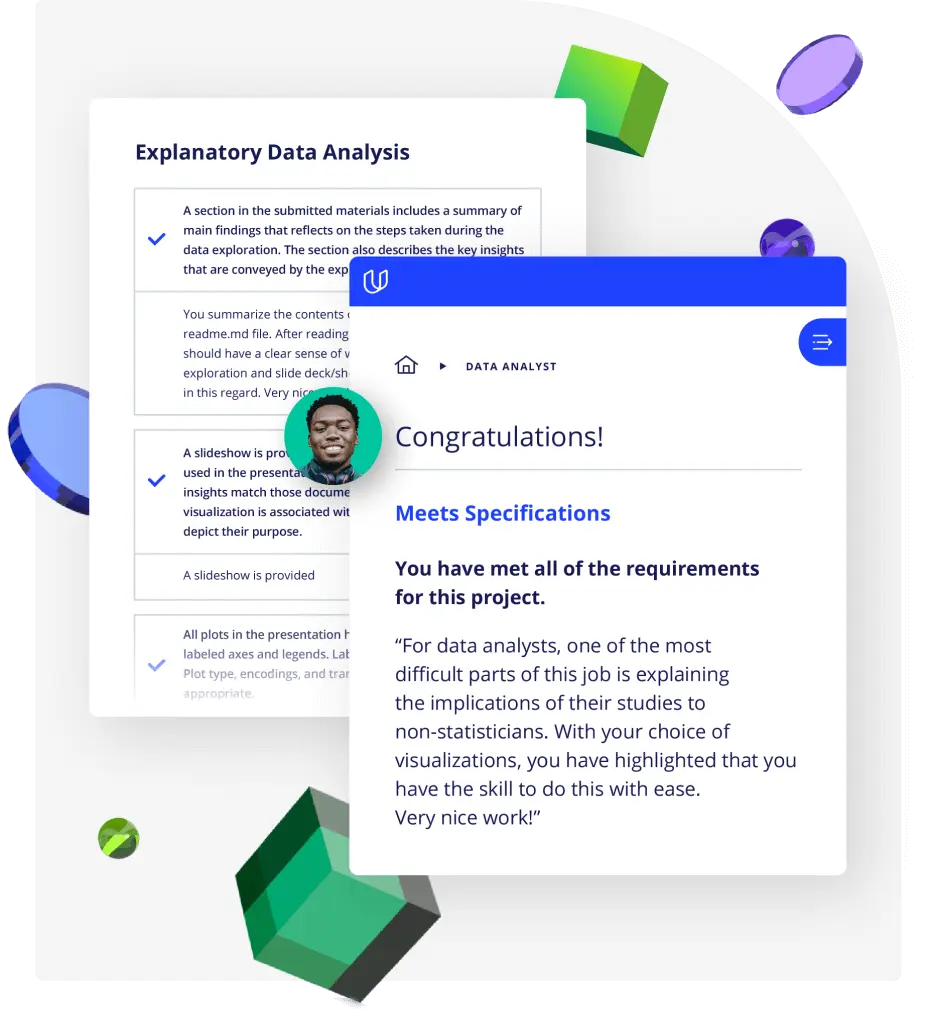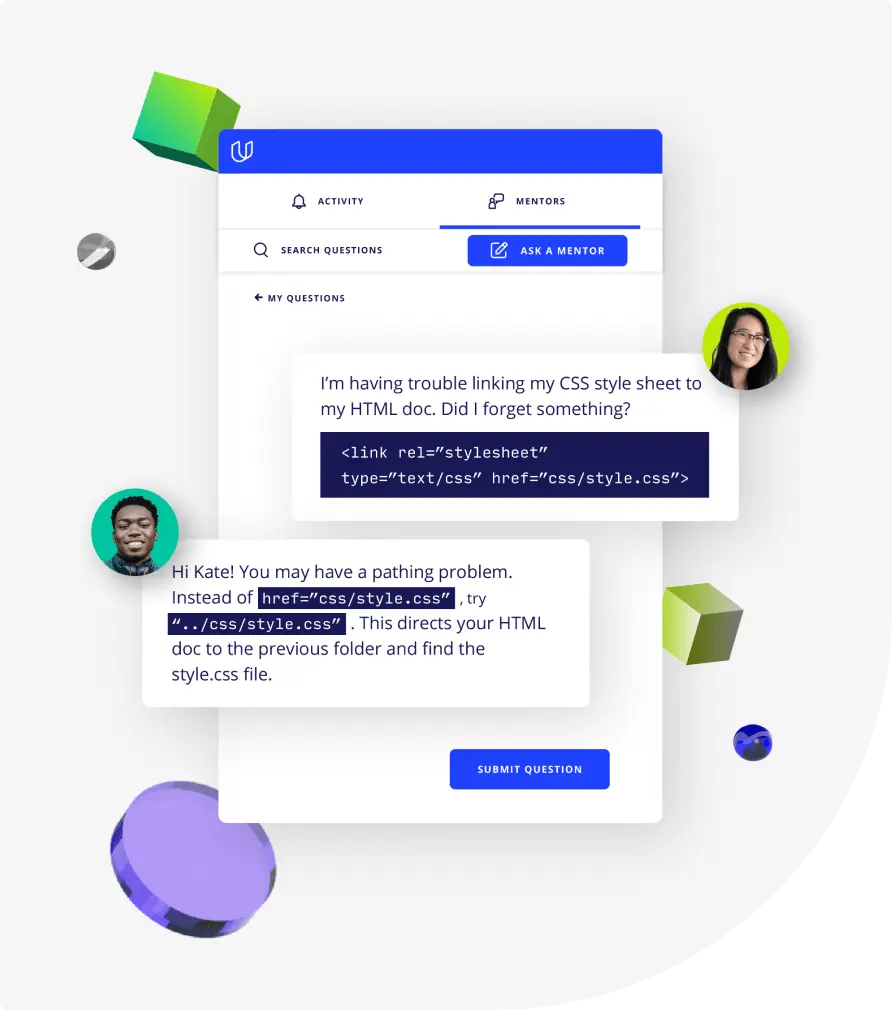Lesson 1
Welcome!
Welcome to Udacity. Takes 5 minutes to get familiar with Udacity courses and gain some tips to succeed in courses.

Nanodegree Program
This Nanodegree provides an overview of embedded systems. You will cover key components like microcontrollers and microprocessors. You'll explore resources, peripheral devices, and the nuances of analog and digital signals before taking an in-depth look at digital signal processing. Here, you'll delve into clocking, logic circuits, gate combinations, and multiplexers, enabling you to construct advanced logical circuits based on truth tables. Lastly, you will learn how to use breadboards for testing and prototyping and understand the intricacies of synchronous and asynchronous processing in embedded systems. In the final project, you will design and implement a microprocessor-based, digital device-control interface.
This Nanodegree provides an overview of embedded systems. You will cover key components like microcontrollers and microprocessors. You'll explore resources, peripheral devices, and the nuances of analog and digital signals before taking an in-depth look at digital signal processing. Here, you'll delve into clocking, logic circuits, gate combinations, and multiplexers, enabling you to construct advanced logical circuits based on truth tables. Lastly, you will learn how to use breadboards for testing and prototyping and understand the intricacies of synchronous and asynchronous processing in embedded systems. In the final project, you will design and implement a microprocessor-based, digital device-control interface.
Beginner
4 weeks
Real-world Projects
Completion Certificate
Last Updated June 8, 2024
Skills you'll learn:
Prerequisites:
Course 1 • 45 minutes
Welcome to Udacity! We're excited to share more about your Nanodegree program and start this journey with you!
Lesson 1
Welcome to Udacity. Takes 5 minutes to get familiar with Udacity courses and gain some tips to succeed in courses.
Lesson 2
You are starting a challenging but rewarding journey! Take 5 minutes to read how to get help with projects and content.
Course 2 • 8 hours
This course will provide an overview of embedded systems, including the history of processing components and the differences between microcontrollers and microprocessors. You will also learn about resources and peripheral devices common to embedded systems and analog and digital signals. By the end of this course, you will be able to design a variety of embedded systems and decode a simple message using the UART protocol.
Lesson 1
This lesson provides a history of processing components, tracing the evolution from vacuum tubes to modern technology. It then differentiates MPUs and MCUs, detailing their respective characteristics.
Lesson 2
This lesson explores the types of resources and peripherals in embedded systems. Then, it's followed by an in-depth review of the most commonly used peripherals within each type.
Lesson 3
This lesson gives an introduction to the characteristics of analog and digital signals and also the tradeoffs between the too. Also, set the foundation for a deeper dive into digital signals.
Lesson 4
Building upon a basic understanding of digital signals, this lesson delves into advanced topics on digital signals, including tri-state logic and various logic families and their integration.
Course 3 • 8 hours
This course covers how digital signals are processed to create advanced circuits in embedded systems. It includes clocking in digital systems, logic circuits, combined logic gates, and multiplexers. By the end of this lesson, you will be able to create advanced logical circuits that match truth tables using logic gates.
Lesson 1
This lesson delves into the purpose of clocking in digital systems, exploring various clock source options along with their respective advantages and disadvantages.
Lesson 2
This lesson expands on basic logic gate skills to cover advanced topics like combined logic gates, DeMorgan's law, and standard logic forms such as DNF & CNF.
Lesson 3
This lesson presents multiplexers (mux), a vital digital electronics concept, and elaborates on the chaining technique to build custom solutions.
Lesson 4
Expanding on prior mux knowledge, this lesson shows how to create a mux from a truth table, implement it using logic gates, and demonstrates these concepts in simulation environments.
Course 4 • 6 hours
This course covers how to connect and program embedded systems. You will learn how to read and create circuit diagrams, see how breadboards are used to test and prototype embedded systems, and learn the differences between synchronous and asynchronous processing.
Lesson 1
Circuit diagrams convey ideas and design plans universally, transcending language barriers. This lesson fosters the ability to interpret this universal symbolism.
Lesson 2
Testing ideas is crucial in electronics, with prototyping as the first step. This lesson offers theory and examples to build breadboard-based prototyping skills.
Lesson 3
Synchronous and asynchronous processing are vital in crafting professional systems. This lesson illustrates these concepts across various layers of the embedded domain.

Embedded Systems Consultant
Ozgur has a 20+ years experience in the embedded systems field with exposure to products in different domains from home entertainment to industrial control, healthcare and automotive. As well as developing professional systems, he is also passionate about learning and explaining complex concepts in simple ways.
Combine technology training for employees with industry experts, mentors, and projects, for critical thinking that pushes innovation. Our proven upskilling system goes after success—relentlessly.

Demonstrate proficiency with practical projects
Projects are based on real-world scenarios and challenges, allowing you to apply the skills you learn to practical situations, while giving you real hands-on experience.
Gain proven experience
Retain knowledge longer
Apply new skills immediately

Top-tier services to ensure learner success
Reviewers provide timely and constructive feedback on your project submissions, highlighting areas of improvement and offering practical tips to enhance your work.
Get help from subject matter experts
Learn industry best practices
Gain valuable insights and improve your skills

Full Catalog Access
One subscription opens up this course and our entire catalog of projects and skills.
Average time to complete a Nanodegree program
4 weeks
, Beginner
8 hours
, Beginner
6 hours
, Beginner
4 weeks
, Beginner
4 weeks
, Beginner
3 hours
, Beginner
6 hours
, Beginner
8 hours
, Beginner
7 hours
, Fluency
8 hours
, Beginner
8 hours
, Beginner
4 weeks
, Beginner
(729)
3 months
, Intermediate
4 weeks
, Intermediate
4 weeks
, Beginner

Embedded Systems Fundamentals
4 weeks
, Beginner
8 hours
, Beginner
6 hours
, Beginner
4 weeks
, Beginner
4 weeks
, Beginner
3 hours
, Beginner
6 hours
, Beginner
8 hours
, Beginner
7 hours
, Fluency
8 hours
, Beginner
8 hours
, Beginner
4 weeks
, Beginner
(729)
3 months
, Intermediate
4 weeks
, Intermediate
4 weeks
, Beginner